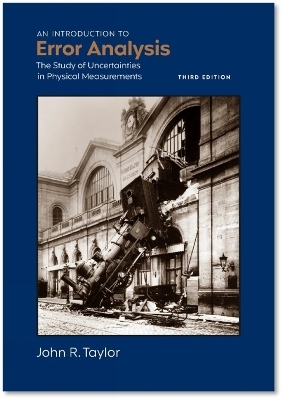
An Introduction to Error Analysis, third edition
The study of uncertainties in physical measurements
Seiten
2022
|
3rd Revised edition
University Science Books,U.S. (Verlag)
978-1-940380-08-7 (ISBN)
University Science Books,U.S. (Verlag)
978-1-940380-08-7 (ISBN)
A new third edition of John R. Taylor’s best-selling text that features Bayesian statistics and updated new chapter-ending problems throughout.
This remarkable text by John R. Taylor has been a non-stop best-selling international hit since it was first published forty years ago. However, the two-plus decades since the second edition was released have seen two dramatic developments; the huge rise in popularity of Bayesian statistics, and the continued increase in the power and availability of computers and calculators. In response to the former, Taylor has added a full chapter dedicated to Bayesian thinking, introducing conditional probabilities and Bayes’ theorem. The several examples presented in the new third edition are intentionally very simple, designed to give readers a clear understanding of what Bayesian statistics is all about as their first step on a journey to become practicing Bayesians. In response to the second development, Taylor has added a number of chapter-ending problems that will encourage readers to learn how to solve problems using computers. While many of these can be solved using programs such as Matlab or Mathematica, almost all of them are stated to apply to commonly available spreadsheet programs like Microsoft Excel. These programs provide a convenient way to record and process data and to calculate quantities like standard deviations, correlation coefficients, and normal distributions; they also have the wonderful ability – if students construct their own spreadsheets and avoid the temptation to use built-in functions – to teach the meaning of these concepts.
This remarkable text by John R. Taylor has been a non-stop best-selling international hit since it was first published forty years ago. However, the two-plus decades since the second edition was released have seen two dramatic developments; the huge rise in popularity of Bayesian statistics, and the continued increase in the power and availability of computers and calculators. In response to the former, Taylor has added a full chapter dedicated to Bayesian thinking, introducing conditional probabilities and Bayes’ theorem. The several examples presented in the new third edition are intentionally very simple, designed to give readers a clear understanding of what Bayesian statistics is all about as their first step on a journey to become practicing Bayesians. In response to the second development, Taylor has added a number of chapter-ending problems that will encourage readers to learn how to solve problems using computers. While many of these can be solved using programs such as Matlab or Mathematica, almost all of them are stated to apply to commonly available spreadsheet programs like Microsoft Excel. These programs provide a convenient way to record and process data and to calculate quantities like standard deviations, correlation coefficients, and normal distributions; they also have the wonderful ability – if students construct their own spreadsheets and avoid the temptation to use built-in functions – to teach the meaning of these concepts.
PART I
1. Preliminary Description of Error Analysis
2. How to Report and Use Uncertainties
3. Propagation of Uncertainties
4. Statistical Analysis of Random Uncertainties
5. The Normal Distribution
PART II
6. Rejection of Data
7. Weighted Averages
8. Least-Squares Fitting
9. Covariance and Correlation
10. The Binomial Distribution
11. The Poisson Distribution
12. The Chi-Squared Test for a Distribution
13. Bayesian Statistics
APPENDICES
A. Normal Error Integral, I
B. Normal Error Integral, II
C. Probabilities for Correlation Coefficients
D. Probabilities for Chi Squared
E. Two Proofs Concerning Sample Standard Deviations
Answers to Quick Checks and Odd-Numbered Problems
Index
| Erscheinungsdatum | 17.05.2022 |
|---|---|
| Verlagsort | Sausalito |
| Sprache | englisch |
| Maße | 184 x 260 mm |
| Themenwelt | Mathematik / Informatik ► Mathematik ► Analysis |
| Naturwissenschaften | |
| ISBN-10 | 1-940380-08-1 / 1940380081 |
| ISBN-13 | 978-1-940380-08-7 / 9781940380087 |
| Zustand | Neuware |
| Haben Sie eine Frage zum Produkt? |
Mehr entdecken
aus dem Bereich
aus dem Bereich
Buch | Softcover (2024)
De Gruyter Oldenbourg (Verlag)
59,95 €


